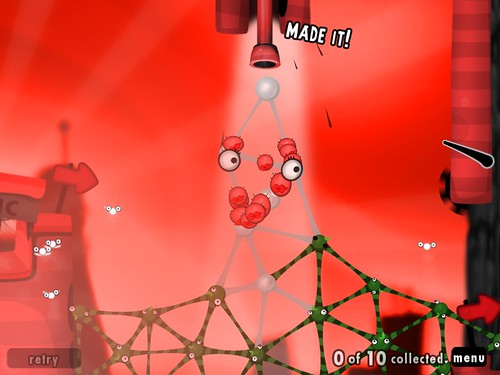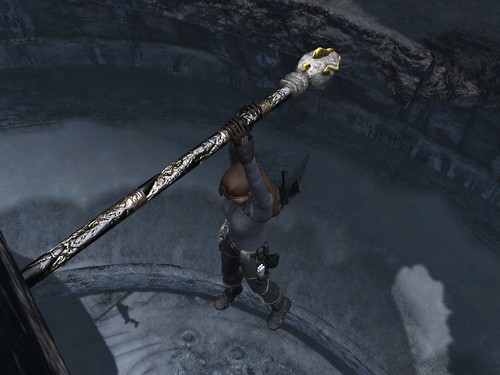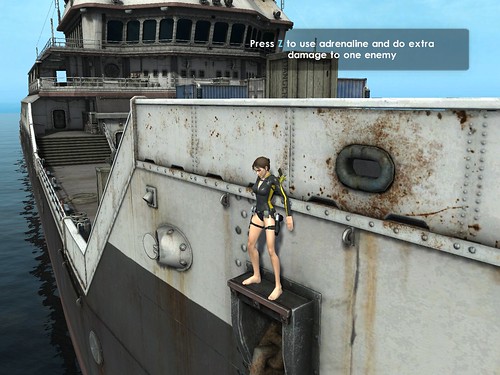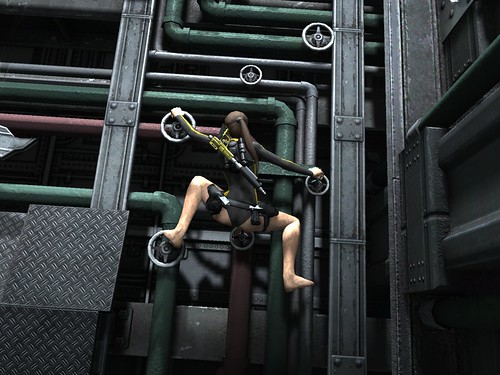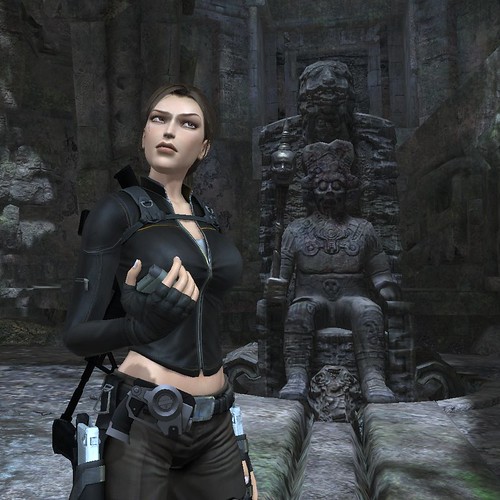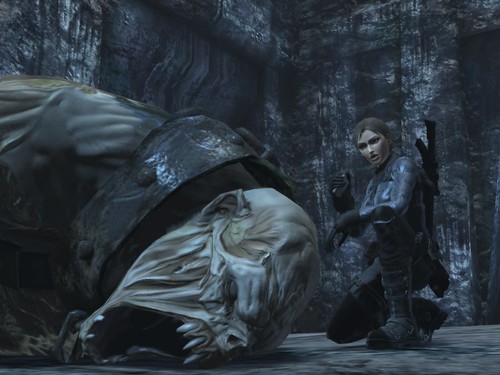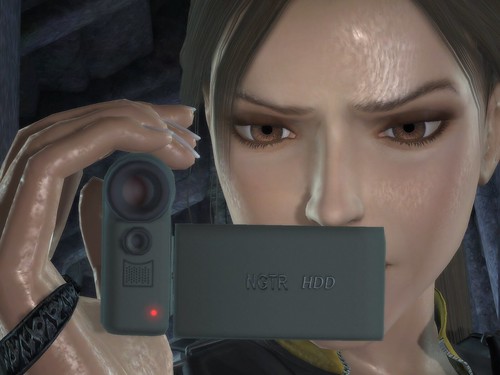TOM FRANCIS
REGRETS THIS ALREADY
Hello! I'm Tom. I'm a game designer, writer, and programmer on Gunpoint, Heat Signature, and Tactical Breach Wizards. Here's some more info on all the games I've worked on, here are the videos I make on YouTube, and here are two short stories I wrote for the Machine of Death collections.
Theme
By me. Uses Adaptive Images by Matt Wilcox.
Search
Mirror’s Edge In Pictures

Just put some of my Mirror’s Edge shots up, and it turns out they make a rather nice slideshow. I’ll have another post or two about it this week.
Update! Fishbro points out that watching this slideshow whilst listening to the game’s theme song, Still Alive (!), quote “Felt good.” I therefore embed it here, that you might stream it in the background while opening the slideshow (which has expanded a fair bit) in a new tab and watching it full-screen. GOOD DAY.
PC Gamer Podcast 24: Admiral Failure & General Vague

Discussers: Tim Edwards, Tom Francis, Craig Pearson and Steve Williams.
Discussees: Crayon Physics Deluxe, Saints Row 2, Mirror’s Edge, Dawn of War 2, Red Alert 3, real-time strategy’s problems, Penguins Arena, Pipe Mania, our picks for the best developer comma ever full stop, Railroads and Sins of a Solar Empire.
Subscribe: here.
Listen:
Mass Effect In Wheels
I love the breadth of choice Mass Effect’s dialogue wheels give you sometimes:

Or the classic:

For some reason it drives me crazy when I can tell, before or after selecting an option, that my character would have delivered the same line no matter what I clicked. For the unfamiliar, Shepard doesn’t say the words you click on, but rather something to that effect. Sometimes there are alarming differences between the two, more often it’s clear the line was phrased to fit all three choices.
If you can’t give me the option, don’t give me the option. There’s plenty of meaningful choice in Mass Effect, punctuating it with meaningless choice only undermines it by making the developers seem lazy and the player’s choices irrelevant.
Plus side, some of them are so good I have to go away and make a cup of coffee before deciding:

I was surprised and pleased to find a lot of commenters here are fans too – I thought any of the other games I mentioned in my last post were more likely to spark a discussion. If you’re playing through at the moment, make sure you hit up Garrus for any old cop stories. My biggest regret when reviewing was that I didn’t follow that lead up before the game ended, and doing so on my second, more Paragonian playthrough was profoundly satisfying.
Bonus points to anyone who knows which two encounters those last decision wheels are from.
2008 In Games That Were Better Than Other Games
I like those gaming-moments-of-the-year lists, but they don’t always tell you what the best games were or even what they were like. So mine’s a games-of-the-year list, but with defining moments instead of descriptions. There’s often a particular experience in a game that exemplifies its appeal, usually the one that springs to mind when you fancy playing it. I’m talking about those rather than highlights or secrets – though often they coincide. This’ll be spoiler-free – indeed, it will at times say nothing meaningful at all – and in descending order: best first.
It’s: a huge open-world action RPG set in Washington two hundred years after a global thermonuclear apocalypse. Wilted fifties chic mixed with zombies being decapitated in slow-motion.

Defining experience: The Oasis
I’m not going to say anything about where or what Oasis is, and the screenshot above isn’t from it. Most people probably complete Fallout 3 without ever finding it – I know I did, first time through. Oasis is just the crowning example of what made Fallout 3 my favourite game this year, and the main thing it has over Oblivion.
I’d heard of it, but I wasn’t looking when I found it. I was just investigating some interesting rocks, as one likes to do on a Sunday. The wasteland is generally pretty flat, but I’d found a complex network of valleys and crags that looked like they might contain something interesting. They did.
Despite its size, and despite is apparent barreness, every interesting-looking place actually is interesting. It doesn’t have Guilds like Oblivion, so its content isn’t organised into neat little mini-careers your character can systematically complete. It’s sown evenly throughout its blasted landscape, leaving little pockets of story, character, treats, secrets and unique treasures.

It’s a brave choice. More people will miss more of Fallout 3’s most extraordinary moments than they did with Oblivion. But once you realise it, once your pessimism about this next house, cave or Vault being a generic one has been disproved often enough, it evokes an explorer’s excitement that I don’t get anywhere else.
But I wish: the skills were more fairly balanced. Small Guns and Repair are just flat out more effective than the others. Melee and Unarmed are crippled because you can’t target bodyparts, and Lockpicking gets its arse kicked by Science because most locked things have a hackable terminal to unlock them.
It’s: a co-operative horror shooter for four people, in which the tide of zombies and superzombies intensifies towards the end of each hour-long campaign.

Defining experience: “TANK!”
“I’ll throw a-”
“Oh God, I’m on fire!”
“So am I!”
“So am I!”
“Hunter!”
“So’s the Hunter!”
“I’ve got him. Look out for the Smo- ack!”
“I’m coming!”
“Help!”
“I’m coming!”
“Aaaargh!”
“I can’t move right now, and I’m still very much on fire, but I am coming!”
“Aaaargh! Look out for the-”
“Aaaaaaargh!”
“AAAAAAH!”
“AAAAAHHH!”
“AAAAAAH!”
“AAAAAAAAAAHH!”
“Heheh. Again?”
But I wish: there was a difficulty mode where the first four levels are frantic, but the finale isn’t impossible. And that Versus mode was just the latter two maps of a campaign, and the Director would give the losing side the Tank earlier or at the same time as it did the winning side.
It’s: a squishy building game in which you conjoin sentient goo-balls with different physical properties to reach your goal.
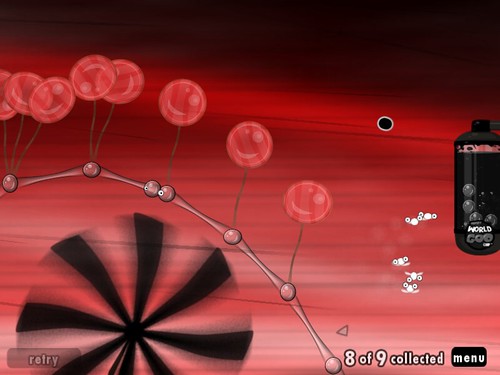
Defining experience: A Blustery Day
Not my favourite level – that’s Red Carpet – but Blustery Day is more typical of World of Goo. A new style of art that the level’s theme exquisitely, a booming score far too stirring for a physics game, and a smart new kind of puzzle that seems impossible until it occurs to you, obvious thereafter.
But I wish: there were fewer simple levels. Early on this makes sense, but later there are one or two where the task is simple but daunting – building a very long bridge, or a very tall tower. I never hit a difficulty spike in World of Goo – it’s eerily close to flawless – but on these few the challenge felt fussy rather than creative.
It’s: a creative adventure in which you play every phase of a species’ life, from the microscopic to the interstellar, designing how it evolves along the way.

Defining experience: “Holy shit, what’s that?”
Spore’s riddled with Star Trek references, but there’s a more profound one that’s not explicit: here’s the game where you seek out new life. There’s an actual galaxy to explore, and you’ll meet species that perhaps one other human has ever seen: their creator.
I know a lot of people got pretty hung up on what they expected from Spore, or what else Spore could have been – and that is an interesting discussion. But I hope it didn’t blind anyone to what Spore actually is: an extraordinary exploration of human creativity, and the home of the most astonishing creatures I’ve ever seen.
But I wish: the other stages were integrated into the Space stage: fight an eco disaster by designing an anti-virus that you then control in the Cell game, impress a warlike race by beating their champion in the Creature game, claim a planet without a colony module by beaming down and starting a Tribe, or mind-control an enemy leader from orbit and take his planet by winning a Civilization game.
It’s: a sci-fi action RPG with guns and science-magic in which you captain a spaceship to search for a single evil alien.
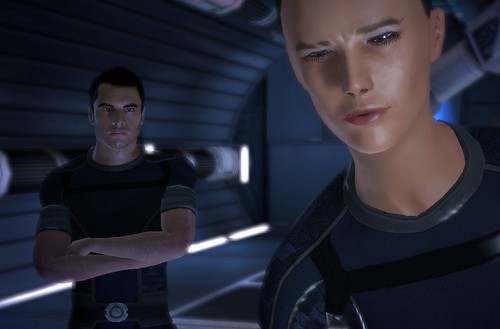
Defining experience: “I’ve had enough of your snide insinuations.”
Actually that’s not the defining experience, but anyone who’s played it and said that line knows why it springs to mind whenever you try to nail down why Mass Effect is so much better than ordinary RPGs. For anyone who hasn’t played it yet, be sure to say it if you ever get the chance.
For me the defining experience was when I’d landed on a new planet, and was asked by security to surrender my weapons. I wasn’t going to do it. Thinking like a gamer, I’d assume the designers would never kill me while I’m defenseless. But I’d become so wrapped up in the character that BioWare’s writers, my decisions, and Jennifer Hale’s exemplary voice acting had collaborated to produce that I wasn’t thinking like a gamer anymore. I was thinking go to hell. You want my weapons? Come and fucking take them, see what happens.
I won’t spoil what the outcome was, but the moral of the story is this: trust Mass Effect. It’s so well written and exciting that you’ll find yourself slipping into a role that’s very much your own – stick with it, and you’ll find the story moulds around it beautifully.
But I wish: exploring a new planet felt a bit more like exploring a new planet. The Mako fun-bus was jarringly at odds with the serious tone of the game, I’d much rather have beamed down on foot.
GTA IV Shorts: Cut Off
PC Gamer Podcast: The Future’s Dim

Ross is still away, so the start is kind of a shambles again. In his absence, myself, Tim Edwards, Craig Pearson and special guest Steve Williams discuss why Prince of Persia sucks so profoundly, why GTA IV’s video editor wins so profoundly, what got cut from World of Goo, and what Valve could call a Left 4 Dead sequel. Stream or download below, or Really Simply Syndicate that bad boy here.
Thoughts On The Team Fortress 2 Christmas Changes

Disclaimer: this expression does not faithfully represent my feelings on these changes.
Left 4 Dead has ceased to be a regular fixture in my schedule, but it somehow made TF2 feel old, or overfamiliar. So I’m mega-, perhaps even ultra-pleased with the timing of the pretty dramatic overhaul that just went live.
Also, Scout update is next, thank God. I was wrong about the Spy hint in the previous TF2 blog post title. I asked Robin about it a while back – he was amused by the extreme scrutiny speculators subjected his wording to. He just has the TF2 script doc open and selects a line at random.
- The Engineer’s teleporters can now be upgraded to level three. It will recharge faster the higher level it is
Great news. They pretty much confirmed this ages ago, but it wasn’t clear if they’d work it into the Engy pack or release it as a separate tweak. It seems like this has to add more variety to viable engy tactics, and just as importantly, more variety to the litany of complaints we can level against our Engies when they inevitably ignore this new ability and hunker down behind their ill-positioned Sentry.
- The Engineer’s dispensers can now be upgraded to level three. It will give out metal and heal faster as it is upgraded
Yay. But I’m guessing this still means placing it right behind you and your Sentry is still the only logical position. One of the main Engy changes I’d like to see is making it viable to place your dispenser where your team most needs it without crippling your own ability to keep yourself and your Sentry alive.
- Spies will be able to recharge their cloaking ability by picking up ammo off of the ground or from health cabinets
The health cabinets thing has been suggested three times a day since the dawn of time, though I can’t say I’ve ever wanted it. When I run out of Cloak, I’m in the enemy base. Because I used my Cloak. You know, to get past enemies. Gobbling up ammo to replenish it is much more interesting to me, because it means less waiting around without encouraging me to walk all the way back to base.
- Some changes to the second part of the first stage of Goldrush to give the attackers more of an advantage
Okay, but I can’t say this is the stage that usually gives me trouble as an attacker. It’s always, always stage 2 cap 2, and trying to assault a good defense of that point is the most miserably futile experience you can have with TF2.
- Any weapons that fire bullets (shotguns, sniper’s machine gun, heavy’s minigun, etc.) can now break apart the Demoman’s stickybombs
Wow, okay, yes. Anything that’s bad for Demomen is fine by me, even when I’m playing Demoman. I didn’t expect them to do this particular nerf, though. One of the few things I like about Demomen right now is they don’t over-abuse their ability to place stickies where it’s impossible to see them before they kill you – more often they use them out in the open for area denial, warning people off a cap. If everyone can destroy them now, I’m a little worried that Demomen are going to learn to always put them in hidden places, and I’ve never discovered any way to anticipate or counter that tactic. Even if you’re looking in exactly the right direction as you round a corner, you’re surely not going to be able to destroy them all before the Demoman can right-click to kill you.
- The icon on the HUD for a person calling for Medic will now give more information to the medic (if the target is low on health, on fire, etc.)
At freaking last! This seemed like such an obvious thing, I thought there must be some complicated technical reason why they didn’t do it in the first place.
- Added an achievement tracker that will allow people to choose specific achievements that they are trying to get
omg tf2=wow ffs valve gay ferrets tldr. Actually this’ll be quite useful. But I’m still not doing most of those Medic ones.
- There is now a custom icon for death messages when the player was killed from a critical hit
GOOD. Now the world shall see that not only am I killed by a critical hit every time I die, but it’s always in a situation and with an amount of health that would guarantee I survive an equivalent non-critical hit and Valve will realise their game is entirely random, sob for a little while, then remove crits forever and issue a public apology. (Hey guys, let’s get into a discussion about whether crits are a good thing.)
- Added a new particle effect for when a player enters the water
+5% to review score.
- Added smoke to the feet of a rocket jumping soldier
+10% to review score.
- Players will now have some particles swirling around them so other players can see when they are overhealed
I heartily endorse this. I think everything mechanically important should be visually apparent (except Cloaked Spies). Now they just need a way to show how hurt players are.
- Attempts by player Pentadact to connect to any servers now result in immediate timeouts, ensuring he can no longer play the game at all
This is the only one I’m not crazy about. I realise I’m inevitably biased, but it just seems unlike Valve to make such a specific tweak. And personally, it’s starting to diminish my enjoyment of the game.
Dear Sir
Ever since it got popular, Spore players have got a little squabbly over getting their stuff into our Sporecast. I have to delete most of the comments I get on my own creations because they’re just people begging.
I’ve also started getting mail from people who’ve found a knock-off of one of their creations in there. Usually I’m happy to add the original and – if I can find it – remove the copy. But somehow one message I got yesterday wasn’t entirely convincing:
“I am requesting that you please remove the mysterious blue box from your sporecast.

This is a blatant theft of my original tardis created 9/5/08 (blue box create date is 9/8/08)… original can be found:”

Extra Mirror’s Edge Levels Blocky, Unrealistic
They’re time-trial levels, where you can race against your own or presumably other people’s ghosts to complete them as quickly as possible. That’s where they evidently think the longevity will be, rather than in extending the plot episodically. But I’m not sure speed-running is for me.
The main basis for my excitement over Mirror’s Edge, apart from the fantastic art, is N. It’s absurdly difficult and endlessly frustrating, but you can retry quickly and there’s enormous scope for finesse. It seems like Mirror’s Edge has a similar process, but I hope speed isn’t the only type of finesse it permits. I never enjoyed trying to maximise my time remaining in N, or speed-run any other game. It was purely about elegance and style.

I tried a speed-run of the first level of Deus Ex once. It went so badly that I actually lost my left leg before I got inside the statue, and I still beat the contemporary fastest time on the Speed Demo Archive.
The bar’s risen quite a bit since then, thankfully, and there’s now a magnificently clever 43 minute run. It turns out grenade-jumping in Deus Ex doesn’t mean what it means in other games, and nano-augmented bunny-hopping is a thing of curious elegance.
This guy has a spectacular way of exiting Maggie Chow’s penthouse suite at maximum speed, never bothers to get his Kill Switch removed, gasses most of UNATCO to get them to open doors for him in their panic, stabs Tracer Tong to shut him up, assassinates Tiffany Savage to save time rescuing her, and pulls off the most laughably improbable escape from the swiftly scuttled Wallcloud. Deus Ex had scope for finesse.
Update: He also survives the most awkward lift ride ever, and there’s something of a surprise ending. I accidentally the whole thing.
Hupdate: Direct download of the super-crisp high quality version of that Mirror’s Edge clip for aesthetes.
Dead Space: The Right-Hand Side Of A Good Game
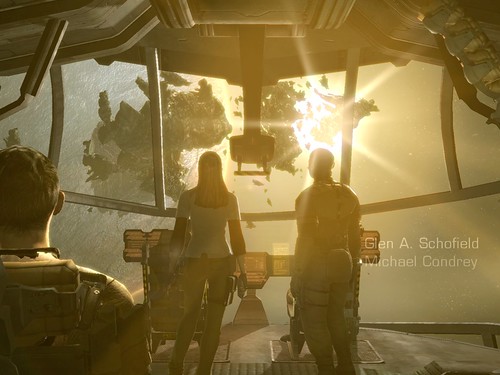
In it, you play a man who is unable to see anything to the left of his nose. Dead Space doesn’t make monsters appear behind you as often as Doom 3 did, but it doesn’t have to: the half who happen to be on your left are just as much of a shock. I have no idea how this camera angle was ever supposed to work.

It’s also obsessed with avoiding any kind of fixed HUD, which means you can’t see your health if you’re near a wall, you can’t see your total ammo in combat, you can’t see part of the map because your own head is in the way, and you have to take your gun out to jump – so that the game can use its LCD screen to tell you whether you’re looking at a surface you’re allowed to jump to. Given that none of these are problems you would face in reality, and assuming the point of avoiding a fixed HUD is to enhance immersion, I’m prepared to call this one a failure.

I used to be fiercely anti-HUD, but now that a few developers have done their best to do away with them, I’m a convert. I still think they can be eradicated eventually, but you’ve made your point guys: none of you are anywhere near figuring out how to do it without profoundly irritating the player. Now for God’s sake have some shame and put your HUDs back. Make them skimpy, see-through and revealing, but please put something on.
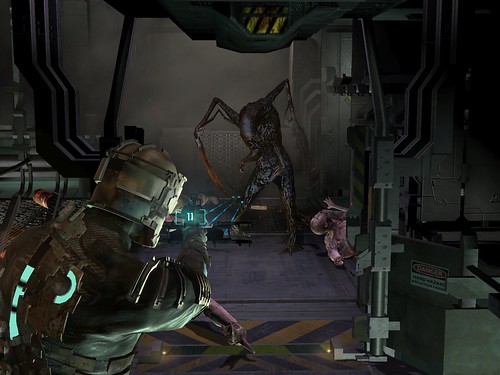
The reason it’s not the right-hand side of a bad or boring game has a lot to do with the monsters. Their concept is only a whisker away from the Generosaurus Meh – I seem to recall we’ve seen badly mutated humans once or twice before – but their more delerious design takes it to uneasy new lows. One of the most common enemies has what look like a child’s forearms protruding below its main claws.
They’d be even more unsettling if this was, as it always should have been, first-person; but you can see just about enough from your ParrotCam to powerfully want these things away from you.
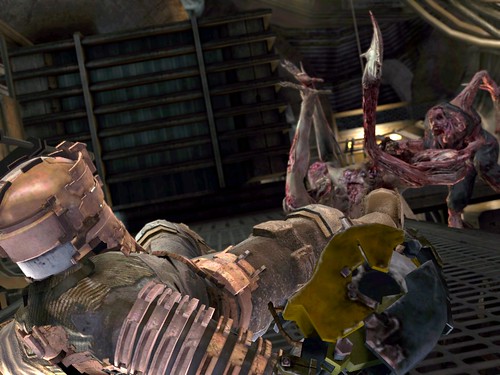
But it’s not so much their look that makes them interesting or fun to fight, it’s what you can do to them. That’s always what gives enemies their ‘feel’ – we can’t really touch the stuff we fight in games, but we quickly acquire near-total knowledge of how they react to almost anything you can do to them, and that’s the way in which we come to know their consistency, resilience and structure.
In Dead Space the primary form of interaction is dismemberment: cutting, blasting or burning whole limbs off at a time, while your enemy is still alive, and then trying to figure out if it has enough functioning fleshsticks left to drag its way towards you and gnash off your own. There’s even a type of zombie that can never die, so the only consideration is how you want to prune it before you turn and run.
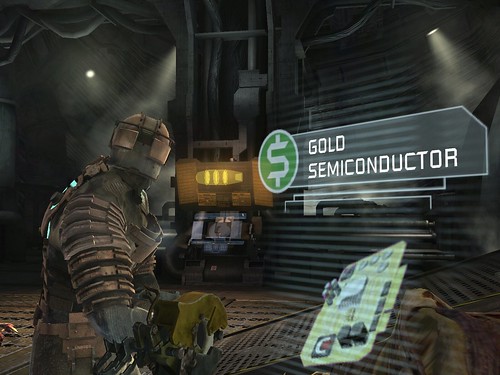
Oh, well here’s where this place went wrong. Gold is enormously conductive.
That makes it satisfying and grisly, and the availability of a remotely guided circular sawblade weapon makes it more so. There’s a very potent and expensive upgrade system that works well, slowmo and a Gravity Gun are thrown in almost as afterthoughts, and stepping out into the vacuum every now and then is a blast of fresh no-air – even if your movement isn’t interestingly different.
The interface and camera angle keep finding new ways to screw you over, but Dead Space scores positively on the simplest metric: I’m glad I bought it, even at a time when Fallout 3 and Left 4 Dead are still new.
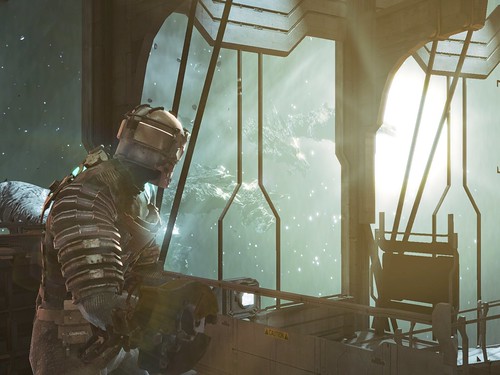
So My Vesper Became Your Chariot

I have a special weak spot for songs that make me laugh with their opening couplet, and I have a special weak spot for spies, and I have a special weak spot for The Decemberists. So this song (via The World Forgot) was always going to win my heart – it didn’t need to be as catchy and fun as it is.
If, like me, you barely understood the basics of the Plame affair at the time, I suggest having it explained to you by Matthew Baldwin while you listen to this. It’s one of those rare occasions when you realise that thing you kept hearing about in the news was actually hugely exciting if you get the right person to tell you about it.
Fallout Girl: The Road To Tenpenny Towers
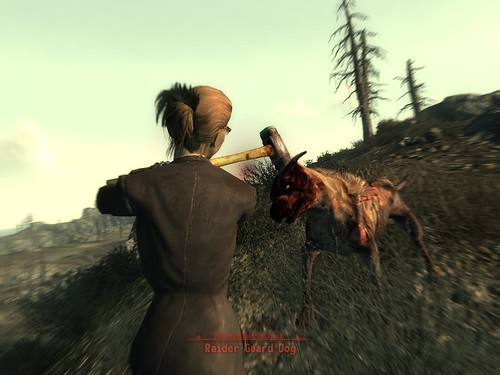
There isn’t one. There’s a cracked blasted rockscape crawling with spitting bloatflies, ravenous hounds and mutant scorpions. It took me the entire freaking night to cross it, so when I arrived at dawn and found someone ahead of me in the queue to get in, I stoved his head in with a tire iron and took over the intercom. Yes, hello, I’m here to see your boss.
I was delighted to find Tenpenny an insular society of bigots, a place oblivious to the suffering of others. I wasn’t wild about Megaton, but the Wasteland was even worse, so I was glad to find a place that had nothing to do with either. I bought a dress only mildly stained with the blood of the dead, a magnificent bonnet to shade my emotionless murderer’s eyes, then pickpocketed my money back and headed up to the penthouse for some light genocide.
On the balcony, I was presented with a big, shiny red button. I gave it a tentative prod.
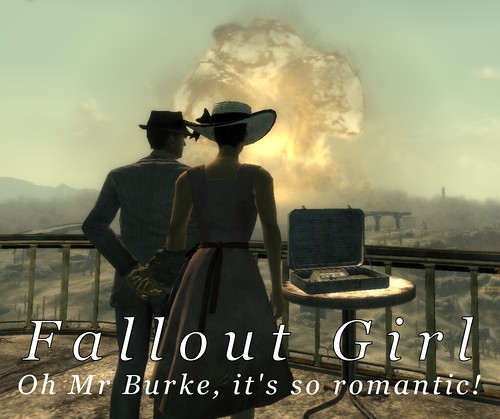
And now we are all sons of bitches.
Actually I guess we’ve been sons of bitches for about two-hundred years at the point Fallout 3 is set. We’re great great great great grandsons of bitches.
This felt like the most destructive thing I’ve ever done in a videogame. I’ve killed billions in DEFCON, but they weren’t unique people things. Megaton is full of carefully crafted stories, characters, homes, secrets, even a whole religion found nowhere else. And less than an hour after I first set eyes on it, it was ash.
It’s probably not much consolation to the citizens of Megaton, but I got a sweet penthouse apartment out of the deal. I picked out a new outfit, had my housebot make me a blond, and bought a house theme: Love Machine.
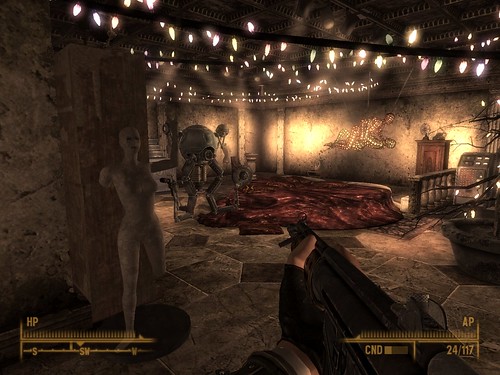
Oh dear God, it’s like a disastrous episode of a post-apocalyptic Changing Rooms. But the nightwear that comes with the heart-shaped bed does go well with my welding mask.
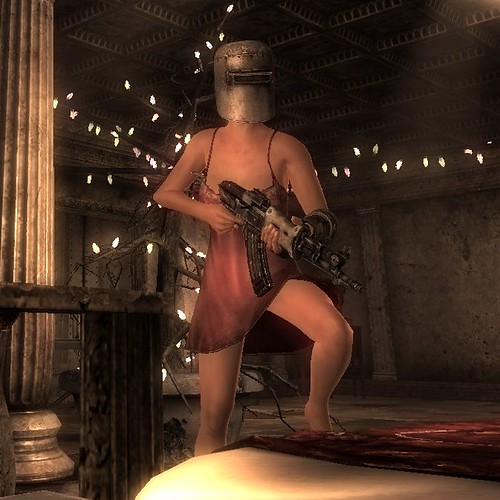
Dressed and rested, I headed back out to the balcony to join Alistair Tenpenny for an afternoon of shooting poor people from our ivory tower.

And I was all set to live a long, peaceful and sheltered life at Tenpenny Tower, until I noticed Tenpenny had a better Sniper Rifle than me.
Revenge Of The Psycho Graverobber
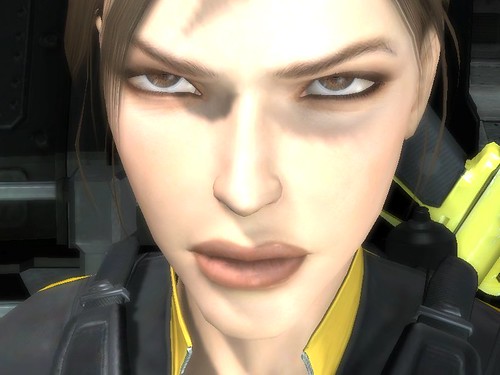
Tomb Raider Underworld just went live on Steam. There’s some absurd fuss kicking up about review scores that you can look up if you care, but one of the many reasons it’s absurd is that the game is extremely good. John Walker did it for us and gave it 86%, I did it for PC Format and gave it 89%.
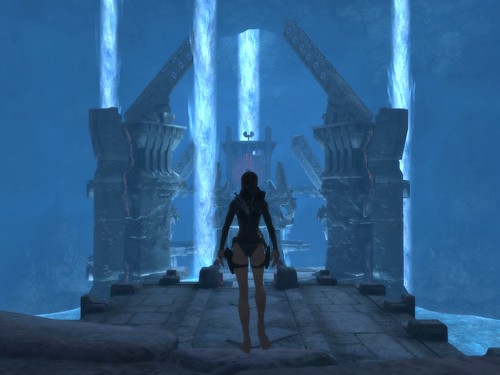
It’s my favourite of the entire series, and the first Tomb Raider game that suggests its creators have some idea of what they’re good at. No bosses, no quick-time events, few traps, and combat that’s brief, sparsely spaced and often actual fun.
I’m not saying buy it – Fallout 3 and Left 4 Dead make everything else an opulence at the moment – I’m saying ask for it for Christmas.

Format only needed three screenshots, but the game is exquisitely detailed and Lara’s face is one of the most smoothly expressive crafted outside of Valve, so I took several hundred. Here are some of the offcuts, click through to the full size ones to see what I mean.
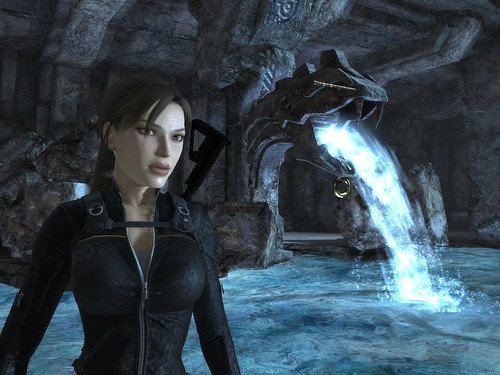
I’m Not Making The Plan Next Time
Thomas Paine in the comments over at 1Fort points out the Leeroy Jenkins of Left 4 Dead.
I love the sheer speed and force with which his plan fails.
